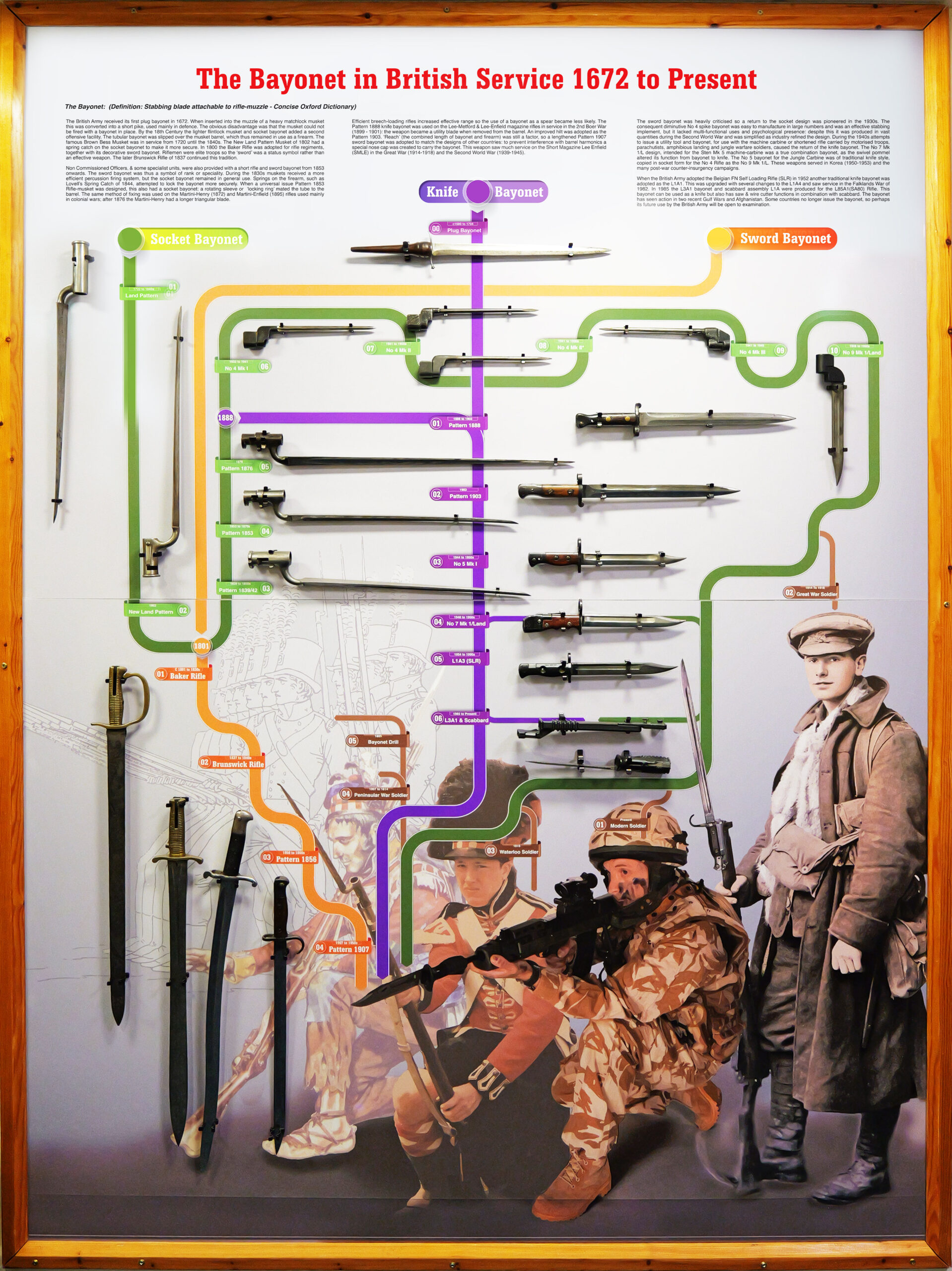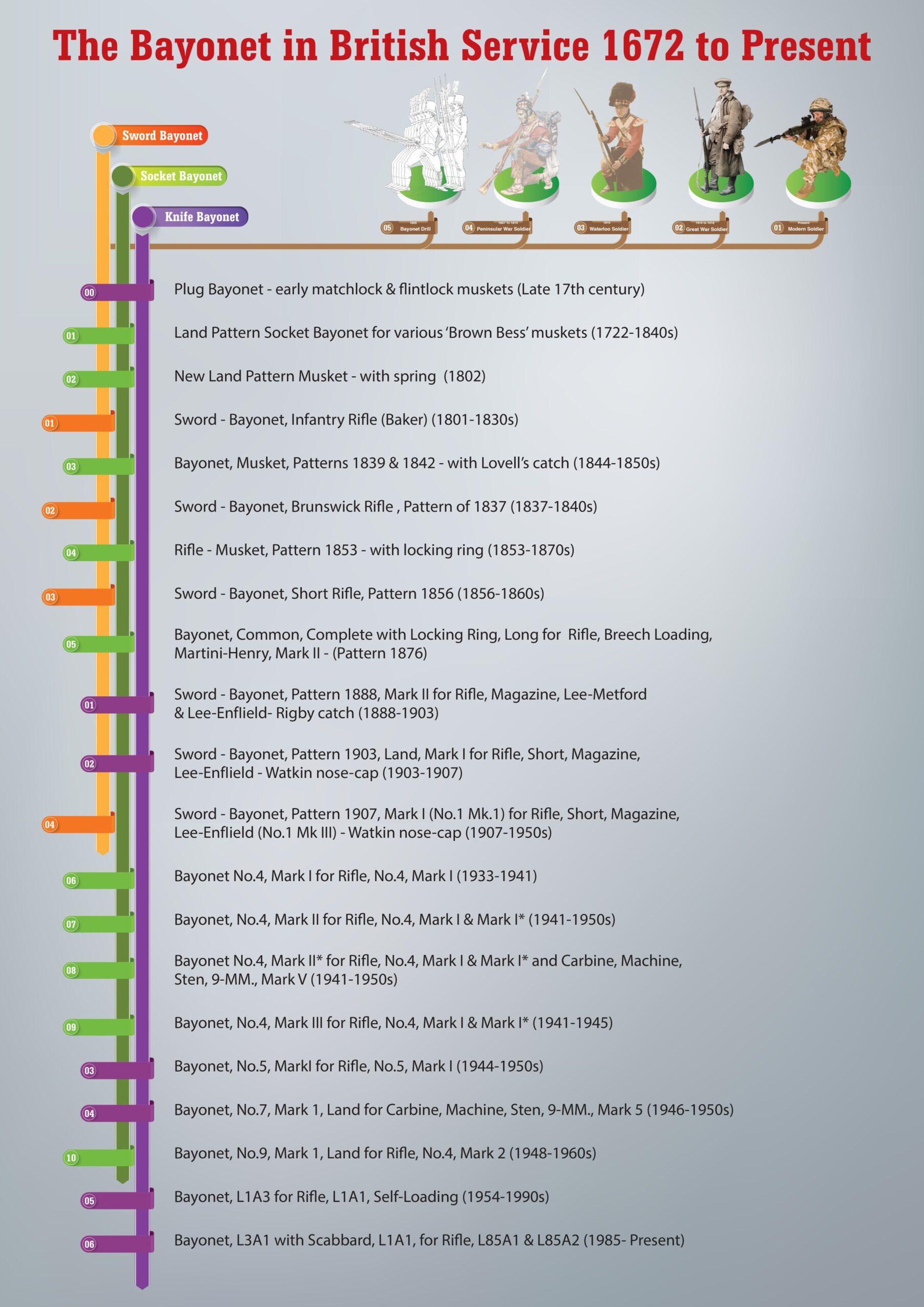The Bayonet in British Service 1672 to Present
The Bayonet: (Definition: Stabbing blade attachable to rifle-muzzle – Concise Oxford Dictionary)
The British Army received its first plug bayonet in 1672. When inserted into the muzzle of a heavy matchlock musket this was converted into a short pike, used mainly in defence. The obvious disadvantage was that the musket could not be fired with a bayonet in place. By the 18th Century the lighter flintlock musket and socket bayonet added a second offensive facility. The tubular bayonet was slipped over the musket barrel, which thus remained in use as a firearm. The famous Brown Bess Musket was in service from 1720 until the 1840s. The New Land Pattern Musket of 1802 had a spring catch on the socket bayonet to make it more secure. In 1800 the Baker Rifle was adopted for rifle regiments, together with its decorative sword bayonet. Riflemen were elite troops so the ‘sword’ was a status symbol rather than an effective weapon. The later Brunswick Rifle of 1837 continued this tradition. Non Commissioned Officers, & some specialist units, were also provided with a short rifle and sword bayonet from 1853 onwards. The sword bayonet was thus a symbol of rank or speciality. During the 1830s muskets received a more efficient percussion firing system, but the socket bayonet remained in general use. Springs on the firearm, such as Lovell’s Spring Catch of 1844, attempted to lock the bayonet more securely. When a universal issue Pattern 1853 Rifle-musket was designed, this also had a socket bayonet: a rotating sleeve or ‘locking ring’ mated the tube to the barrel. The same method of fixing was used on the Martini-Henry (1872) and Martini-Enfield (1895) rifles used mainly in colonial wars; after 1876 the Martini-Henry had a longer triangular blade.
Efficient breech-loading rifles increased effective range so the use of a bayonet as a spear became less likely. The Pattern 1888 knife bayonet was used on the Lee-Metford & Lee-Enfield magazine rifles in service in the 2nd Boer War (1899 – 1901): the weapon became a utility blade when removed from the barrel. An improved hilt was adopted as the Pattern 1903. ‘Reach’ (the combined length of bayonet and firearm) was still a factor, so a lengthened Pattern 1907 sword bayonet was adopted to match the designs of other countries: to prevent interference with barrel harmonics a special nose cap was created to carry the bayonet. This weapon saw much service on the Short Magazine Lee Enfield (SMLE) in the Great War (1914-1918) and the Second World War (1939-1945). The sword bayonet was heavily criticised so a return to the socket design was pioneered in the 1930s.
The consequent diminutive No 4 spike bayonet was easy to manufacture in large numbers and was an effective stabbing implement, but it lacked multi-functional uses and psychological presence: despite this it was produced in vast quantities during the Second World War and was simplified as industry refined the design. During the 1940s attempts to issue a utility tool and bayonet, for use with the machine carbine or shortened rifle carried by motorised troops, parachutists, amphibious landing and jungle warfare soldiers, caused the return of the knife bayonet. The No 7 Mk 1/L design, intended for the Sten Mk 5 machine-carbine was a true combination bayonet, as the swivel pommel altered its function from bayonet to knife. The No 5 bayonet for the Jungle Carbine was of traditional knife style, copied in socket form for the No 4 Rifle as the No 9 Mk 1/L. These weapons served in Korea (1950-1953) and the many post-war counter-insurgency campaigns.
When the British Army adopted the Belgian FN Self Loading Rifle (SLR) in 1952 another traditional knife bayonet was adopted as the Ll A1. This was upgraded with several changes to the Li A4 and saw service in the Falklands War of 1982. In 1985 the L3A1 bayonet and scabbard assembly Ll A were produced for the L85A1(SA80) Rifle. This bayonet can be used as a knife but also has saw & wire cutter functions in combination with scabbard. The bayonet has seen action in two recent Gulf Wars and Afghanistan. Some countries no longer issue the bayonet, so perhaps its future use by the British Army will be open to examination.

